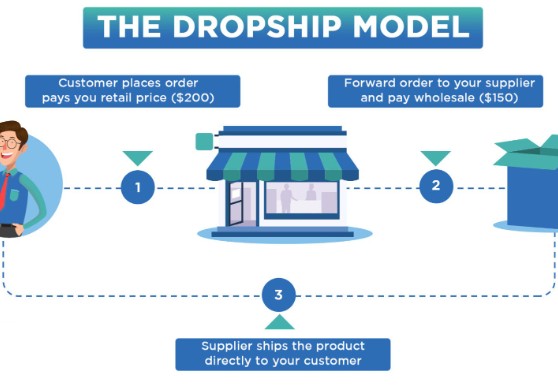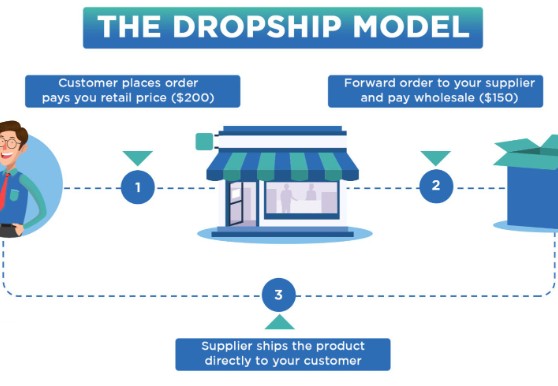How To Build A Successful Dropshipping Business
Building a successful dropshipping business is an enticing prospect for many aspiring entrepreneurs. The dropshipping model allows individuals to operate an online store without holding inventory, making it an accessible entry point into eCommerce. However, while the barrier to entry may be low, achieving success requires careful planning, the right tools, and a solid understanding of market dynamics. This article will explore essential strategies for establishing a thriving dropshipping business and highlight the best dropshipping platforms available in 2024.
Understanding Dropshipping

Dropshipping is a retail fulfillment method that allows businesses to sell products without maintaining an inventory. Instead, when a store sells a product, it purchases the item from a third party, typically a wholesaler or manufacturer, who then ships it directly to the customer. This process eliminates the need for a physical storefront and reduces overhead costs.
Key Benefits of Dropshipping
- Low Startup Costs: One of the most significant advantages of dropshipping is that it requires minimal upfront investment. Entrepreneurs can start a business without the financial burden of purchasing and storing inventory.
- Flexible Location: Dropshipping businesses can be operated from virtually anywhere, as long as there is an internet connection. This flexibility is particularly appealing to digital nomads and those looking for a side hustle.
- Wide Product Range: Dropshippers can offer a vast selection of products without having to stock them physically. This ability to pivot quickly and test new product ideas can be a significant advantage in the competitive eCommerce landscape.
- Scalability: As the business grows, dropshippers can easily expand their product offerings without the challenges associated with managing inventory and warehousing. This scalability allows entrepreneurs to respond swiftly to market demands.
- Reduced Risk: Since dropshippers only purchase products after a sale is made, there is less financial risk involved. Unsold inventory is not a concern, allowing for a more agile business model.
Choosing the Best Dropshipping Platforms
Selecting the right dropshipping platform is crucial for the success of your business. Each platform has unique features and benefits that cater to different types of entrepreneurs. Below are some of the best dropshipping platforms available in 2024:
1. Shopify
Shopify is one of the leading eCommerce platforms, known for its user-friendly interface and extensive features tailored for dropshipping businesses. With Shopify, entrepreneurs can set up an online store quickly and easily.
Pros:
- User-friendly interface that simplifies the store setup process.
- A vast ecosystem of apps and integrations, including dropshipping tools.
- Responsive customer support available 24/7.
Cons:
- Monthly fees can accumulate, especially if you opt for premium apps.
- Transaction fees apply unless you use Shopify Payments as your payment processor.
Price: Plans start at $29/month, with higher tiers available for more features.
Features:
- A customizable online store with a variety of themes.
- Secure payment gateways and robust checkout options.
- Comprehensive analytics to track performance.
2. WooCommerce
WooCommerce is a popular plugin for WordPress that transforms a standard website into a fully functional eCommerce store. It is an excellent choice for those already familiar with WordPress and seeking a highly customizable solution.
Pros:
- Free to use, making it budget-friendly for startups.
- Extensive customization options through various plugins and themes.
Cons:
- Requires some technical know-how to set up and maintain.
- Additional costs may arise from purchasing hosting and premium plugins.
Price: The plugin is free, but hosting costs can range from $100 to $500 per year.
Features:
- A wide range of customizable themes designed for eCommerce.
- Integration with various payment gateways, including PayPal and Stripe.
- Access to powerful analytics and reporting tools.
3. BigCommerce
BigCommerce is a robust eCommerce platform that caters to businesses of all sizes, offering a suite of features that support dropshipping effectively.
Pros:
- No transaction fees, which allows for better profit margins.
- Built-in features for SEO and multi-channel selling.
Cons:
- The interface can be overwhelming for beginners.
- Limited themes compared to other platforms, which may affect store design.
Price: Plans start at $29.95/month, with options for larger businesses.
Features:
- Advanced SEO features to improve search engine visibility.
- Integration with popular marketplaces like Amazon and eBay.
- Comprehensive reporting and analytics tools.
4. Oberlo
Oberlo is a dropshipping app designed specifically for Shopify users. It allows entrepreneurs to easily import products from suppliers into their Shopify store, streamlining the order fulfillment process.
Pros:
- Simple integration with Shopify, allowing for quick product import.
- Automated order fulfillment and inventory management.
Cons:
- Limited to use with Shopify, restricting its versatility.
- Some products may have long shipping times, affecting customer satisfaction.
Price: Free for basic use with Shopify; additional features are available in paid plans.
Features:
- Real-time inventory updates to prevent overselling.
- Product customization options to enhance branding.
5. Spocket
Spocket is a dropshipping platform that connects users with suppliers primarily based in the US and EU, enabling faster shipping times compared to sourcing from suppliers in Asia.
Pros:
- Access to high-quality products with competitive prices.
- Branded invoicing options, which enhance the customer experience.
Cons:
- Limited selection compared to some competitors.
- Higher pricing for premium plans.
Price: Plans start at $24/month.
Features:
- A curated selection of products from reliable suppliers.
- Real-time inventory synchronization to streamline order processing.
Comparison Table
| Platform | Use Case | Pros | Cons | Price | Key Features |
|---|---|---|---|---|---|
| Shopify | Beginners | User-friendly, extensive apps | Monthly fees, transaction fees | From $29/month | Customizable store, secure payments |
| WooCommerce | WordPress users | Free, highly customizable | Requires technical know-how | Free + hosting | Extensive customization options |
| BigCommerce | All business sizes | No transaction fees | Overwhelming for beginners | From $29.95/month | Advanced SEO, multi-channel selling |
| Oberlo | Shopify users | Easy product import | Limited to Shopify | Free | Real-time inventory updates |
| Spocket | Fast shipping | Quality products, branded invoicing | Limited selection | From $24/month | Curated products from reliable suppliers |
Benefits of Using Dropshipping Platforms
Using a dropshipping platform can significantly enhance the efficiency and effectiveness of your business operations. Here are some key benefits:
Streamlined Operations
Dropshipping platforms automate various aspects of the business, including inventory management, order processing, and customer communication. This automation reduces the time spent on mundane tasks and allows you to focus on more strategic activities, such as marketing and customer service.
Scalability
As your business grows, dropshipping platforms make it easy to expand your product offerings without the challenges of managing inventory and warehousing. This scalability is essential for adapting to changing market demands and exploring new product lines.
Access to Analytics
Most dropshipping platforms provide comprehensive analytics tools to help you understand customer behavior, sales trends, and marketing effectiveness. By leveraging these insights, you can make data-driven decisions that improve your business strategy and ultimately boost sales.
Reduced Shipping Times
Choosing platforms that connect you with suppliers in the same region as your target customers can help reduce shipping times. This reduction can lead to increased customer satisfaction, as faster shipping often correlates with positive buying experiences.
Enhanced Customer Service
Many dropshipping platforms offer built-in customer service tools, enabling you to manage inquiries and resolve issues efficiently. Providing excellent customer service can set your business apart from competitors and build customer loyalty.
Real-World Example Products
To further illustrate how dropshipping can be successfully implemented, let’s explore some platforms and tools that can help you build your business:
1. Oberlo
Oberlo is a dropshipping app designed to integrate seamlessly with Shopify, allowing users to import products from suppliers easily. Its user-friendly interface makes it an ideal choice for beginners.
Features:
- Automated order fulfillment.
- Real-time inventory updates.
Price: Free with Shopify plans.
Use Case: Oberlo is ideal for beginners looking to start a dropshipping business with minimal effort, allowing you to focus on marketing and customer acquisition.
2. Spocket
Spocket connects users with suppliers based mainly in the US and EU, allowing for quicker shipping times and higher-quality products.
Features:
- Wide range of high-quality products.
- Branded invoicing for an enhanced customer experience.
Price: Plans start at $24/month.
Use Case: Spocket is great for entrepreneurs aiming to provide a premium customer experience by offering faster shipping and quality products sourced locally.
3. Printful
Printful is a print-on-demand service that enables you to sell custom-designed products without holding any inventory. This model is particularly appealing to creative entrepreneurs.
Features:
- Custom branding options.
- A wide range of products, including apparel, accessories, and home goods.
Price: Free to use, with a cost per product sold.
Use Case: Printful is perfect for artists and designers looking to monetize their work without the risk of unsold inventory.
Key Strategies for Building Your Dropshipping Business
Now that you have a solid understanding of dropshipping and the platforms available, let’s explore the key strategies you need to implement to build a successful dropshipping business.
Conduct Thorough Market Research
Before launching your dropshipping business, it’s crucial to conduct thorough market research. Identify trends, analyze your competition, and understand your target audience. This research will help you select the right products and marketing strategies.
- Identify Niche Products: Focus on niche markets that have demand but limited competition. Tools like Google Trends and keyword research can provide valuable insights into what customers are searching for.
- Analyze Competitors: Study successful dropshipping businesses in your niche. Analyze their product offerings, pricing strategies, and marketing tactics. This analysis will provide valuable information to inform your strategy.
- Understand Your Audience: Develop customer personas to understand who your target audience is, their preferences, and their pain points. This understanding will help you tailor your marketing messages and product offerings effectively.
Build a Professional Online Store
Your online store serves as the face of your business, so it’s essential to create a professional and visually appealing website. Choose a platform that allows you to design a user-friendly and mobile-responsive store.
- Select a Theme: Choose a clean and attractive theme that aligns with your brand identity. Make sure the design is user-friendly and optimized for mobile devices, as a significant portion of online shopping occurs on smartphones.
- Optimize for SEO: Incorporate SEO best practices into your store, including keyword-rich product descriptions, meta tags, and alt text for images. A well-optimized store will rank higher in search engine results, driving more organic traffic.
- Add High-Quality Images: Use high-quality product images to enhance the visual appeal of your store. Consider including multiple angles and lifestyle shots to give customers a better understanding of the products.
- Create Compelling Product Descriptions: Write engaging and informative product descriptions that highlight the benefits and features of each item. Focus on how the product solves a problem or fulfills a need for your customers.
Implement Effective Marketing Strategies
Once your store is up and running, it’s time to attract customers. Effective marketing strategies will help you build brand awareness and drive traffic to your site.
- Leverage Social Media: Utilize social media platforms like Instagram, Facebook, and Pinterest to promote your products and engage with your audience. Create visually appealing content and consider running paid advertising campaigns to reach a broader audience.
- Content Marketing: Start a blog related to your niche to establish authority and provide value to your audience. Share tips, how-to guides, and industry news to attract potential customers and drive traffic to your store.
- Email Marketing: Build an email list to keep in touch with your customers. Use email marketing to promote new products, share exclusive offers, and send personalized recommendations based on customer preferences.
- Influencer Partnerships: Collaborate with influencers in your niche to reach a wider audience. Influencer marketing can build trust and credibility for your brand, driving traffic and sales to your store.
Provide Excellent Customer Service
Delivering exceptional customer service can significantly impact your business’s reputation and customer loyalty. Here are some strategies to enhance customer service:
- Responsive Communication: Respond promptly to customer inquiries via email, chat, or social media. Quick and helpful responses can create positive impressions and foster customer loyalty.
- Easy Returns and Refunds: Establish clear return and refund policies. Ensure customers feel secure in their purchases, knowing they can return items if needed.
- Solicit Feedback: Encourage customers to provide feedback on their shopping experience. Use this feedback to improve your processes and address any concerns.
- Create a FAQ Section: Develop a comprehensive FAQ section on your website to address common questions and concerns. This proactive approach can reduce customer inquiries and enhance the shopping experience.
Continuously Analyze and Optimize
Building a successful dropshipping business is an ongoing process that requires constant analysis and optimization.
- Track Performance Metrics: Use analytics tools to monitor website traffic, conversion rates, and customer behavior. Identify which marketing strategies drive the most sales and adjust your approach accordingly.
- Test and Experiment: Conduct A/B testing on product pages, pricing strategies, and marketing campaigns to determine what resonates best with your audience. Continuous testing can lead to improved performance over time.
- Stay Updated on Trends: Keep an eye on industry trends and emerging technologies. Adapting to changes in the market can help you stay competitive and meet customer demands.
- Network and Learn: Join dropshipping communities and forums to connect with other entrepreneurs. Share experiences, learn from others’ successes and failures, and stay informed about industry best practices.
Conclusion
Building a successful dropshipping business in 2024 is an attainable goal for aspiring entrepreneurs willing to put in the effort and dedication required. By understanding the dropshipping model, choosing the right platforms, and implementing effective strategies, you can create a thriving online store. Remember that success won’t happen overnight; it takes time, persistence, and continuous learning. Stay committed to your goals, embrace challenges, and adapt to the ever-changing eCommerce landscape. With determination and the right approach, you can build a profitable dropshipping business that stands the test of time.



